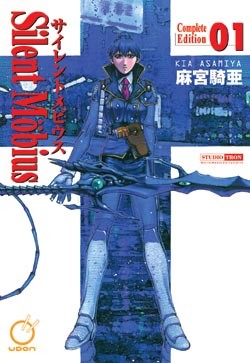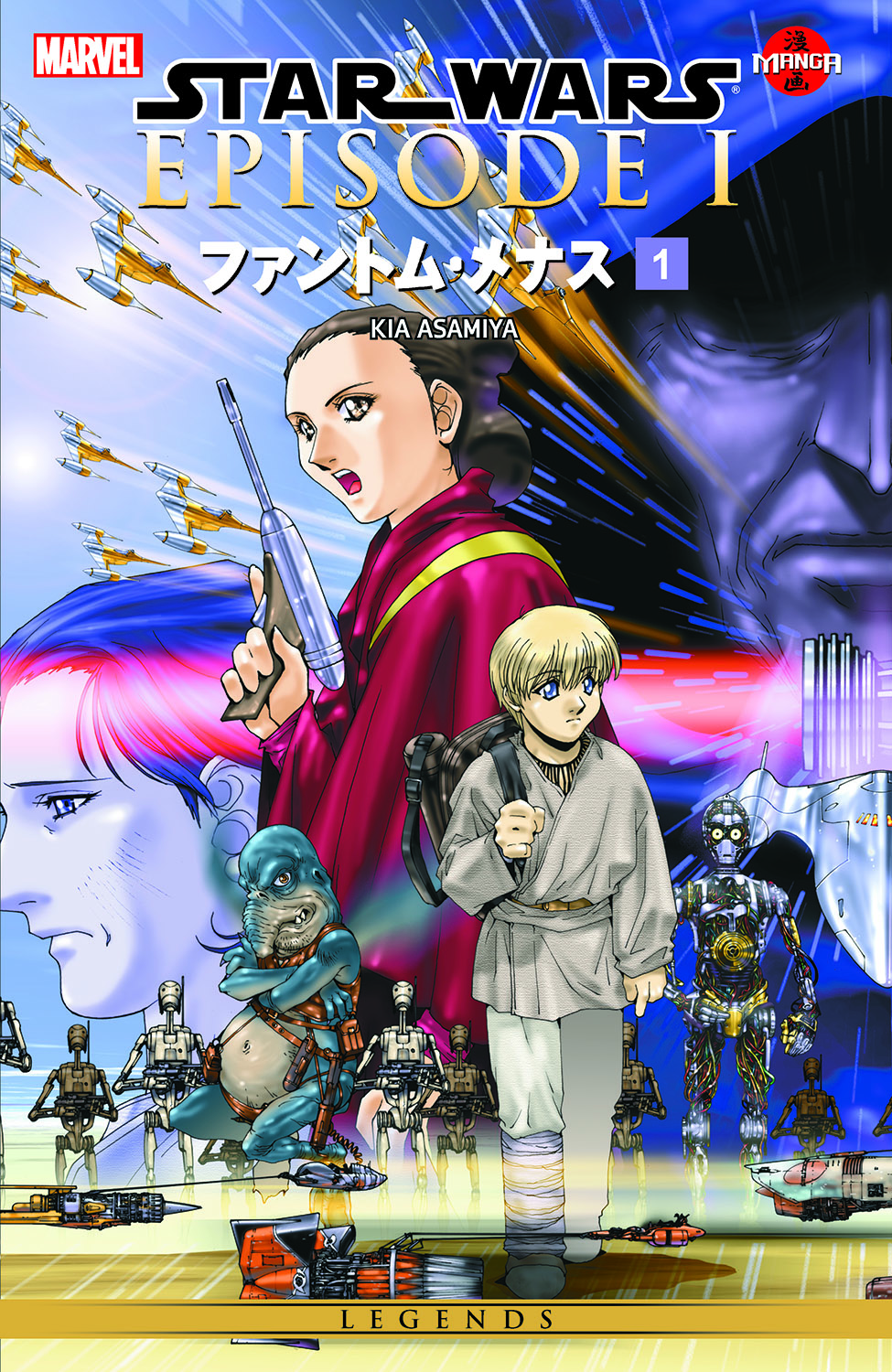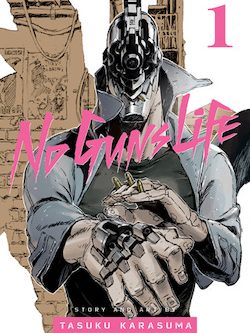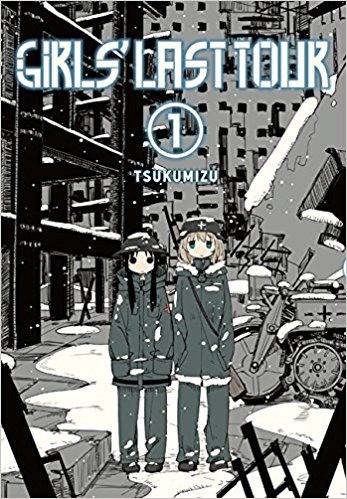I like science fiction, I really do, but I have limited tolerance for certain tropes: futures in which all the women dress like strippers — or worse, fascist strippers — futures in which giant bugs menace Earth, and futures in which magic and technology freely commingle. Small wonder, then, that Kia Asamiya’s Silent Möbius has never been on my short list of must-read manga — it’s a festival of cheesecake, gooey monsters, and pistol-packing soldiers who, in a pinch, must decide whether to cast a spell or fire a rocket launcher at the enemy. Imagine my surprise when I discovered just how entertaining Silent Möbius turned out to be, gratuitous panty shots, bugs, and all.
When shorn of its mystical mumbo-jumbo and elaborate character histories, Silent Möbius is, at heart, a classic “They came from outer space!” tale. The story begins in 2026, when the Earth is under siege from interdimensional beings known as Lucifer Hawks, fierce, shape-shifting beasties that can assume a variety of forms: dragons, humans, oversize millipedes. Only a small team of elite agents — the so-called Attacked Mystification Police Force (AMP) — are capable of killing the Hawks with a mixture of up-to-the-minute technology and good old-fashioned sorcery. Where the Hawks are coming from and why remains mysterious — at least in the very early stages of the story — though we learn that one agent’s father may be responsible for opening the floodgate between Earth and the Hawks’ home world.
If the plot is pedestrian, Asamiya’s towering cityscapes and appealing character designs aren’t. To be sure, there are plenty of other sci-fi manga from the 1980s and 1990s peddling similar visions of a dysfunctional future paved in concrete and lit by neon, but Asamiya and his helpers pull off even the busiest compositions, bringing the urban scenes to energetic life; I dare you not to compare Silent Möbius with Blade Runner. (Someone else must have thought so, too, as Asamiya was tapped to do the manga adaptation of Star Wars: The Phantom Menace, yet another work that pilfered visuals from Scott’s ground-breaking film.) Then there are the character designs: each member of the AMP seems to be taking her grooming cues from the golden age of MTV, when video vixens came in two flavors: those with enormous feathered hair, and those with short, heavily lacquered locks. Better still, their uniforms consist of jackets with epaulets, neckties, and stirrup leggings. Who knew that 2026 would look suspiciously like 1986?
The other thing that won me over was the characters. I wouldn’t construe Asamiya’s decision to make the AMP a strictly female force as a nod to feminism; there are enough costume failures and half-clad characters to suggest Asamiya was as interested in satisfying the male gaze as he was in promoting the idea that women can kick ass just as well as men. At the same time, however, the ladies of AMP are tough and decisive, and don’t take guff from their male peers; in one of the series’ few nods to realism, the largely male police force resents the AMP for their ability to assume control of any investigation, grumbling about jurisdiction and occasionally baiting the women into fights.
Not that Silent Möbius doesn’t have moments of eyeball-rolling stupidity. Asamiya saddled his characters with borderline stripper names, for example: who but an adult entertainer would choose a name like “Rally Cheyenne” or “Katsumi Liqueur”? (Worse still: Katsumi’s father was Gilgelf Liqueuer, a name best suited for a drunken Hobbit.) Then, too, the series’ rather complicated mythology isn’t well explained; it’s the kind of universe where some characters kill aliens by drawing pentagrams on the ground while others use bazookas. And the cheesecake… sigh. I often had the sinking feeling that Asamiya was secretly auditioning to do a Pirelli Tire calendar with his frequent images of semi-naked women in provocative poses.
Costume failures and panty shots aside, I enjoyed the first volume of Silent Möbius well enough to continue with the series. It’s a fun, escapist romp that occasionally takes itself a little too seriously, but never bogs down in its own ridiculous mythology.
SILENT MÖBIUS: COMPLETE EDITION, VOL. 1 • BY KIA ASAMIYA • UDON ENTERTAINMENT • 200 pp. • RATING: OLDER TEEN (16+)




Michelle Smith says:
Yay, I’m glad you liked it! I think the cityscapes are largely responsible for why I liked it, too. Also, the part about the hobbit made me snicker. 🙂
Katherine Dacey says:
The names were something else, weren’t they? I think Asamiya is a proud graduate of the Moto Hagio School for Outrageous Names.
Thanks for urging me to pick this up!
Serdar says:
I made the mistake (so to speak) of attempting to read this back when it was still only in Japanese, and was not sure if it was my command of the language that was at fault or that Kia Asamiya just needed to partner with a better writer. I’ve since read it in English, and while I still think it’s all recycled parts, it’s nevertheless great to look at.
Adding your site to my blogroll by way of S1E1.com, btw!
Katherine Dacey says:
It definitely has a Frankenmanga vibe to it, doesn’t it? I agree that Asamiya’s writing is just OK, though the new English edition has a good, solid translation that makes it pretty accessible for those of us who don’t read Japanese.
And thanks for the blogroll add — I just did the same for Genji Press as well. I really enjoyed your contributions to last month’s Manga Movable Feast!
Jade says:
It’s sad to compare even the most random sampling of cheesecake shonen/seinen heroines of the eighties and nineties to female characters today. But now that I think about it, I’ll raise you a comparison of the hot-blooded, beefcake boys of the eighties and nineties to today’s ineffectual, unmotivated losers.
Characters, in general, have just been so desaturated for general appeal or contrived to suit the complaints of ‘sophisticated’ fans, that it’s nice to see the odd Katsumi Liqueur pop along living and vibrant despite a ridiculous name.
Ah, also if panty shots aren’t a deal-breaker for you, I’d suggest looking into Ratman. It’s actually quite entertaining, but I didn’t recommend it since there’s some fan service here and there which I thought would turn you off it because you had a big issue with fan service in Diamond Girl, which had only hints of fan service. *inhale* I can foresee a future where the fates of the interesting female characters turn me off to the series, but volume one was fun.
Katherine Dacey says:
Thanks for the suggestion, Jade! I know I’m getting a reputation for being a cranky feminist prude when it comes to cheesecake, but the presence of some gratuitous panty shots isn’t an automatic deal-breaker for me if the story and the characters are good. I actually liked Diamond Girl better than you might have thought from my review; I just could have done without some of the panty shots and bath tub scenes.
I’ve heard good things about Ratman, but your endorsement has persuaded me to add it to my buy list.
Jade says:
Sorry, Kate! The prude stereotypes damaged the feminist popular movement as much as psychotic self-aggrandising theatrics like S.C.U.M. so it’s not a connection I just casually make. In fact, I’d say the ‘prude’ thing damaged the aims by dissolving the distinction between exploitation and genuine feminine sexuality in many people’s minds. I really never meant to ever suggest that you are a feminist and therefore you must also be a reactionary prude. I can’t stand that line of thinking.
You’ve mentioned before that you have a lower tolerance for cheesecake and whatnot due to your upbringing though, so when I’m considering your take on certain books or thinking of suggesting something, I try to be a bit more sensitive.
I should have just mentioned the Ratman content as more of a warning aside though. I can see now how my comments could, on a bad day, possibly read like, ‘Oh! Since your ideology isn’t quite as backwards and ignorant as I previously thought, you may enjoy something else that isn’t written for tiny children!’ :3
Katherine Dacey says:
I wasn’t the least bit offended by your comments, just trying to reassure you that I don’t usually faint at the sight of male-friendly fan service. (I’m a big fan of Empowered, for example.) I appreciate your consideration, however — it’s one of the reasons I trust your book recommendations, especially when it comes to books that are heavier on the boobs, blood, and bullets.
I am a feminist, and I’ve cheerfully self-identified as such as long as I’ve known what the word meant! I take full ownership of that. (Hence my self-mocking description of myself as a cranky feminist prude.) My reaction to fan service doesn’t come from a feminist standpoint so much as a general belief that things are much sexier when they aren’t shoved in the audience’s face. So much fan service is crude and obvious that I often find it detrimental to the story. And that goes for fan service aimed at women, too; a good-looking male character in a sharp business suit is more likely to pique my interest than a character who has an allergy to shirts, no matter how many loads of laundry I could wash on his abs. Some of my preference is undoubtedly a product of being raised Catholic (though thankfully I didn’t go to parochial school), and some of it reflects my own movie and book-reading habits; I find the The Thin Man a whole lot sexier than Mr. and Mrs. Smith, even if Myra Loy and William Powell aren’t as genetically perfect as Angela Jolie and Brad Pitt.
All of this is just a long-winded way of saying that if I mention fan service, it’s only because it pulled me out of the story. So no worries! I have the utmost respect for your opinions, and am glad you feel comfortable disagreeing with me or telling me to lighten up a bit.
Jade says:
Ah, I was pretty sure you weren’t offended, but I did want to clarify the fact that I do respect how you feel about fan service and it isn’t just, ‘Oh, there’s Kate being squeamish about a hemline again.’
You raise some really good points about discretion though. At the end of the day, when I’m done raving about free expression, I don’t always give enough thought towards tasteful depiction and ‘less is more.’ On the other hand, though there’s value in a tasteful presentation, that line is co-opted to rob ‘tasteless’ works of any merit. I don’t know your thoughts on John Waters, but his work has a certain brand of artistic merit and in the manga world, Reiko the Zombie Shop provides a truly evocative experience that just can’t be expressed in a more tactful work. On the mutant third hand, I can see a clear line between a sincere observation of a tacky aspect of nature and a work that is tacky in its pandering presentation.
Either way, I’ve been trying to unravel the mystery of how to pull off ironic fan service for a while…any thoughts?
Katherine Dacey says:
John Waters is a great exception to the “less is more” rule! The original Hairspray was un-PC, vulgar, and filled with scenery-chewing performances, but it was infinitely more enjoyable than the either the stage or the film music it inspired, both of which were sanitized, pallid evocations of the original. So yes, over-the-top can be entertaining, too; I can’t imagine wanting to read a restrained Black Lagoon, for example.
As for ironic fan service… what are your thoughts on Empowered? I don’t know if it’s ironic, exactly, but Adam Warren gets a lot of mileage out of having his cheesecake and eating it, too: you can read Empowered as a brilliant satire on superhero comics, or as a T&A festival.
david brothers says:
I laughed out loud twice here. Once was your point about fascist strippers (and I immediately thought of a few, and there’s even one in my beloved One Piece: http://onepiece.wikia.com/wiki/Sadi-chan), and the second was at “Gilgelf Liqueur,” whose name sounds like something you’d do after drinking too much “Gilgelf Liqueur” on a rowdy night out.
The thin line between quality cheesecake and too much is a tough one to walk. I think Adam Warren manages it admirably in Empowered, in part because he throws enough humor in that the cheesecake isn’t marring a super serious tale like it does in so many superhero comics and in part because he seems remarkably cognizant of it. I mean, he calls it his “sexy superhero comedy.”
I’ve been reading Yuji Shiozaki’s Battle Vixens. I bought three volumes years ago, like in 2004. I know it was back when Tokyopop was pumping out titles by the dozen and I was dutifully buying a whole lot of them, even the Suikoden III adaptation and several volumes of Getbackers. I haven’t even looked at these since I got them, since the story is pretty unfamiliar thus far, and I’m not entirely sure how to write about them. I don’t think that they’re any good, like a Black Lagoon or Dogs might be, but they’re interesting in a really weird and baffling way. It’s goofy and stupid and SO in your face with the T&A that it doesn’t even come across as anything but rote, rather than sexy. It has all the usual ingredients, but there’s SO much of it that it isn’t sexy at all. It’s like a chocolate cake that’s six feet tall and twenty feet across. It’s the Bad Boys II of cheesecake manga, where the interest comes from the extreme excess, rather than anything plot or character related.
It’s the sort of book that’d normally be pretty off-putting to me. It’s way, way over the edge of my T&A tolerance, but so far over that it keeps me curious. I read it with a furrowed brow and a “Oh, that’s what’s going to happen next? Really?” face.
Jade says:
I’m not familiar with Empowered, but I’ll see if I can give it a shot this week. That’s probably the best way to pull it off though, somewhere between satire and tribute.
David, I think you’ve given some good examples of the humour vs. exploitation dynamic in satirical fan service. I’m not so sure about the intent behind Battle Vixens, but from what I’ve seen, the result is definitely far too ridiculous to take too seriously. I really can’t believe the creator ever intended to portray women in a generally bad light either.
Out of the far too much manga that I read, I do actually like a few ridiculously ribald titles like Sundome, Battle Club and Gunsmith Cats. I think part of why I’m not bothered by it in those stories is because it’s coupled with such strong female characters such as with Silent Moebius, here. In stories where the cheesecake is a woman being taken advantage of or it’s presented as a negative trait, that bothers me. I suppose that ties into our discussion of Diamond Girl, but I think that scene didn’t bother me since it ultimately reflected badly on the skirt-flipper himself, though I could see that sort of thing becoming a running gag and thus reflecting as an entitlement for that character in the future. It would bother me then.
About 75% of the shojo series I’ve read have a story where the heroine jokes and brags about how she’s just as good as a guy at whatever. Maybe she just sits in a relaxed position or shows some other sign of comfort in the male lead’s presence. Later, male lead pushes her up against a wall, maybe rips her shirt or dress a teeny tiny bit and implies how easily he could rape her, to which the heroine is thankful for the important object lesson he has taught her. The intent behind most fan service is an erection; this scene is specifically designed as a cautionary tale for female readers to know their place. Frankly, that disgusts me more than T&A, but my point is that, at least for me, the intent counts for far more than how graphically the sexuality is portrayed.
Katherine Dacey says:
It’s like a chocolate cake that’s six feet tall and twenty feet across. It’s the Bad Boys II of cheesecake manga, where the interest comes from the extreme excess, rather than anything plot or character related.
I almost snarfed my tea reading those sentences — that’s possibly the best description of Battle Vixens ever written. As for fascist strippers, see Seraphic Feather: ladies with Nazi officer hats, skimpy unitards, heels, and garter belts. (Basically, what Lady Gaga wears to the supermarket on a Tuesday.)
What the question of fan service boils down to is what you’re talking about, Jade: entitlement. I can handle a few panty shots or images of heaving cleavage if the female characters aren’t just objects of fantasy or abuse.